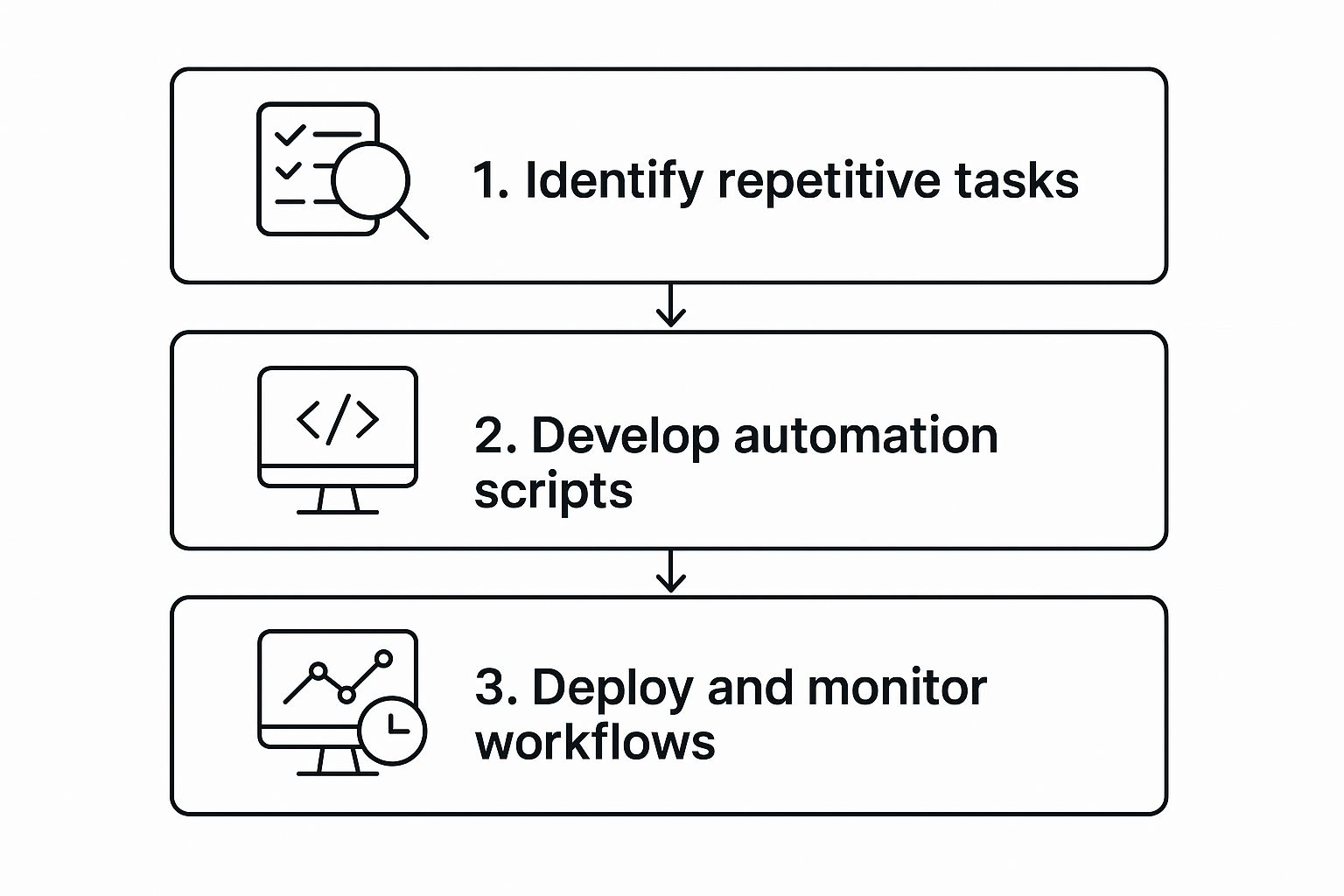- Published on
How to Automate Repetitive Tasks: Boost Productivity Today
- Authors

- Name
- Gabriel
- @gabriel__xyz
That five-minute task you do every day? It adds up to over 20 hours per year. Learning how to automate those repetitive jobs isn't just about saving a few minutes here and there; it's a core strategy for getting your focus back and making a real impact.
The True Cost of Doing It Manually

It’s so easy to write off small, recurring tasks as "just part of the job." We’ve all been there—compiling that weekly report, manually onboarding a new client, or cross-posting social media updates. In the moment, they feel like no big deal.
But those minor drains accumulate into a massive drag on your team's productivity and ability to innovate.
The problem runs deeper than just lost time. Manual processes are a breeding ground for human error. One mistyped number in a spreadsheet or a single missed step in an onboarding checklist can snowball into hours of damage control.
This constant, low-level friction also kills morale. Let's be honest, no one gets excited about mind-numbing copy-paste work. It’s the exact opposite of the creative, high-impact problem-solving that actually drives growth and makes people feel good about their jobs.
Uncovering the Hidden Downsides
The costs of manual work are often invisible until you really look. Think of them as hidden taxes on your team's potential, showing up in a few key ways:
- Opportunity Cost: Every hour spent on a manual task is an hour you didn't spend on strategic planning, talking to customers, or coming up with the next big idea.
- Reduced Agility: Manual workflows are slow and rigid. They make it incredibly hard for your team to pivot or adapt when things change—which they always do.
- Knowledge Hoarding: Critical processes can become trapped with one person who knows the "right way" to do them, creating frustrating bottlenecks for everyone else.
We've all seen how these small inefficiencies add up. The table below breaks down the real-world costs of common manual tasks that are prime candidates for automation.
The Hidden Costs of Manual Tasks
| Manual Task Example | Time Cost Per Week | Risk of Human Error | Impact of Automation |
|---|---|---|---|
| Creating weekly sales reports | 2-3 hours | High (data entry mistakes) | Frees up sales team for selling; provides real-time, accurate data |
| Onboarding new hires | 4-5 hours | Medium (missed steps) | Ensures a consistent, positive experience; reduces HR admin time |
| Cross-posting social media content | 1.5 hours | Low (typos, wrong links) | Guarantees consistent messaging; allows for better content planning |
Seeing the numbers laid out like this makes it clear: the time suck is just the beginning. The real loss comes from the cumulative drag on focus, quality, and morale.
The most dangerous phrase in the language is, "we've always done it this way." Sticking with manual processes simply because they are familiar means you are actively choosing inefficiency over growth.
It's a widespread issue. A staggering 94% of companies are bogged down by repetitive, time-consuming tasks. To get ahead, you have to understand how to streamline business processes using AI automation effectively. Recognizing automation as a business necessity—not just a technical luxury—is the first real step toward giving your team back its most valuable resource: their focus.
Finding Your First Automation Wins

Before you can start automating anything, you have to figure out what to automate. It's a common trap to go looking for complex, flashy problems to solve. The reality is, the best candidates for automation are usually the small, annoying tasks hiding in your daily routine.
The trick is to start a simple “workflow audit.”
You're not trying to overhaul everything overnight. The goal is to find a few low-effort, high-impact wins that give you and your team some time back right away. This builds momentum and makes it much easier to get buy-in for bigger projects down the road.
How to Spot Prime Automation Targets
So, where do you start looking? Prime automation targets usually have a specific DNA. They're the jobs that are frequent, follow a clear set of rules, and often just involve shuffling data from one app to another.
To unearth them, ask yourself and your team a few direct questions:
- What's the most annoying part of your day? Annoyance is a huge red flag for a clunky process that's begging to be fixed.
- What's that one task you dread doing every single week? The things we procrastinate on are often perfect candidates for a machine to handle.
- Where do mistakes happen most often? Manual data entry, copying and pasting, or following complex checklists are error-prone—and easily automated.
Try keeping a simple log of your daily tasks for just one week. Seriously, just a week. Note down every repetitive action, how long it takes, and how you feel about it. You’ll be surprised how quickly a prioritized list of potential automation wins starts to form.

This idea from Zapier perfectly illustrates how to categorize these tasks. You're looking for the stuff in that high-frequency, low-focus quadrant. Those are your quick wins, the tasks that drain your mental energy without adding much value.
Start with the task that, if you never had to do it again, would make your week significantly better. That's your first target. Don't overthink it—focus on the immediate relief.
This initial process isn’t really about technology. It's about observation. Once you’ve pinpointed a few high-value targets—like, say, manually sending GitHub PR notifications to Slack—then you can move on to finding the right tool for the job.
Choosing Your Automation Toolkit

Alright, you've pinpointed the manual tasks bogging you down. Now for the fun part: picking the right tool to automate them. The market is packed with options, but don't get overwhelmed. They really boil down to three main types, and knowing the difference is key to making a smart choice.
First up, you have the no-code platforms. Think of tools like Zapier or Make. These are built for simplicity, with visual drag-and-drop interfaces and straightforward "if this, then that" logic. You can connect thousands of apps without touching a single line of code, making them a fantastic starting point for common business workflows like data entry or email management.
Then there are the specialized, single-purpose tools. These are designed to solve one specific problem, and they do it incredibly well. For instance, a dev team getting tired of chasing pull request updates could use a dedicated tool like PullNotifier. It's built specifically to connect GitHub to Slack for clean, real-time PR notifications—a narrow but persistent headache that a generalist tool just can't fix as elegantly.
Matching the Tool to Your Needs
The third group is script-based or code-heavy solutions. If you've got some development chops, writing your own scripts in Python or using platforms like GitHub Actions gives you ultimate power and flexibility. This is the way to go for truly unique or complex tasks where off-the-shelf software just won't cut it, but it obviously requires technical skills to build and maintain.
So, how do you choose? It all comes down to your specific needs and comfort level:
- For broad business tasks: No-code platforms are the fastest and most accessible path to automation.
- For a specific, recurring pain point: A specialized tool usually delivers a more polished and effective solution.
- For custom, complex workflows: Writing your own scripts gives you complete control.
The goal isn't to find the single "best" automation tool on the market. It's to find the best tool for the specific, annoying task you're trying to get off your plate. Start with the simplest solution that works.
This move toward automation isn't just a trend; it's a strategic shift. By 2024, around 60% of companies had already integrated some form of automation. Marketing teams, for example, are using it 76% more than sales teams, a clear sign of its strategic value. To see how other businesses are putting these tools to work, you can explore the latest automation statistics and industry insights. Choosing the right tool isn't just about saving a few minutes; it's a smart investment in your team's efficiency.
A Real-World Example: Automating GitHub PR Notifications in Slack
Theory is great, but let's get our hands dirty. I want to walk you through a real-world scenario that solves a massive headache for dev teams: keeping track of pull request (PR) status changes on GitHub.
Manually checking for updates or nagging reviewers in Slack is a huge focus killer. It grinds the development cycle to a halt. This is the perfect kind of repetitive, low-value task that's just begging to be automated.
For this, we'll use a specialized tool called PullNotifier. Instead of the noisy, default integrations that flood a channel with updates, this approach keeps everything tidy in a single, consolidated thread for each PR.

As you can see, any successful automation project starts with nailing down the repetitive workflow before you even think about the technical side of things.
Setting Up Your First Workflow
First things first, you'll need to connect your GitHub and Slack accounts. It’s a pretty standard process handled through secure authentication.
Once you’re linked up, you can start building rules to send notifications exactly where they need to go. A common setup I've used is mapping PRs from a specific GitHub repository straight to a dedicated Slack channel, like #dev-team-reviews.
This simple step is a game-changer. No more important updates getting buried in a general-purpose channel. You can even configure it to automatically ping the right reviewers, making sure nothing ever falls through the cracks. If you're curious about what's out there, exploring different GitHub Slack integrations available can give you a better idea of what fits your team's needs.

The interface is straightforward. You can customize notifications based on the PR's status—like when it's opened, approved, or has new comments—giving you fine-tuned control over the noise.
The real goal here isn't just to blast notifications everywhere. It's to create a single, reliable source of truth for each pull request. This completely eliminates the need for developers to constantly check GitHub or ask for status updates in Slack.
With a simple workflow like this active, the entire code review process instantly becomes more transparent and efficient. It’s a practical example of how a small automation can have a huge impact on team productivity, freeing up everyone's time for more important work. This turns an abstract idea into a concrete, achievable win.
Building an Automation Strategy That Lasts
Getting your first automated workflow up and running is a great start, but it’s definitely not the finish line. If you want to see real, lasting value, you need to think bigger than a single, one-off fix and build a strategy that sticks. Too many automation projects fizzle out because they don't have a solid foundation.
It’s about more than just buying the right software. In fact, a staggering 70% of digital transformation projects fall short of their goals, mostly because the strategic side of things gets ignored. To sidestep that pitfall, you can discover more automation insights and industry data that really drive home the importance of a good plan.
Start Small and Document Everything
The best way to begin is with a small, manageable pilot project. Instead of trying to automate an entire department's operations overnight, pick one specific, high-pain task that’s bogging everyone down. This approach lets you learn the ropes, prove the value of automation, and iron out any kinks on a small scale.
And as you go, document every single step. This isn't just busywork—it's crucial. Good documentation ensures anyone on your team can understand, manage, or troubleshoot the workflow down the road. An undocumented automation quickly becomes a mysterious black box that nobody dares to touch.
Frame automation as a tool that empowers your team, not one that replaces them. It’s about eliminating the boring work so people can focus on the creative, high-impact problems that machines can't solve.
This mindset is key to building trust and getting everyone on board. For a concrete example of a small, well-documented automation that helps a team, check out our guide on how to automatically assign reviewers in GitHub.
Have Questions About Automation? We Have Answers.
Jumping into automation for the first time? It's natural to have a few questions. Getting those sorted out is the first step to confidently reclaiming your time. Let's walk through some of the most common ones I hear from other developers.
Automation vs. AI: What’s the Real Difference?
One of the biggest hang-ups is telling automation and AI apart. They sound similar, but their jobs are completely different.
Think of automation as a strict, literal command-follower. You set up a rule—"When a pull request is opened, send a notification to the #dev-team channel"—and it will execute that exact command perfectly, every single time. It's all about predefined instructions.
AI, on the other hand, tries to mimic human thinking. An AI could, in theory, analyze the content of a pull request, identify its complexity, and then suggest the best-suited reviewer from the team based on their past work. Automation follows your script; AI writes its own.
Do I Actually Need to Be a Coder?
Nope. Not at all. While knowing how to code definitely opens up more advanced, custom solutions, you can start automating plenty of your workflow today with zero technical expertise.
The rise of no-code and low-code platforms has completely flattened the learning curve. If you can think in "if this, then that" terms, you have all the skills you need to build a surprisingly powerful workflow.
Tools like Zapier and Make use simple visual interfaces to connect the apps you're already using every day. For teams that want more control and deeper customization, you can always explore more technical solutions like using GitHub Actions to send Slack notifications.
Is This Going to Be Expensive?
This is a big one, and the answer is almost always no—especially when you're just starting out. Most of the top automation platforms have generous free plans that are more than enough to get your first few workflows up and running.
As your needs grow, you can scale up to paid plans. But the return on your investment is almost immediate when you consider the value of the hours you get back each week.
Ready to eliminate the noise from your code review process? Get focused, real-time PR updates right in Slack with PullNotifier. Start for free at https://pullnotifier.com.